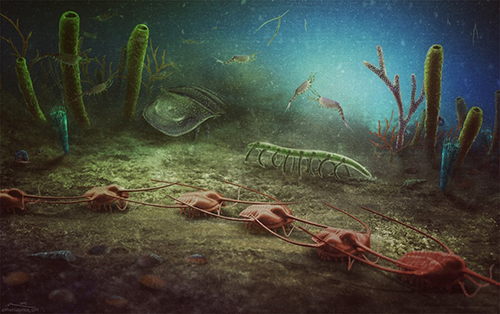Publication of the LGL-TPE in the journal Nature Ecology & Evolution on February 9, 2024. Press alert of CNRS on February 9, 2024.
A new fossil bed has been uncovered in the French department of Hérault through the perseverance of two ardent amateur palaeontologists. The couple’s discoveries at the Cabrières site, near Pézenas, were studied by an international team including scientists from the CNRS(1) and the University of Lausanne. The ancient environment represented by the 470-million-year-old fossils, over 400 in number, is the closest to the Ordovician south pole hitherto discovered. Among the most bountiful and diverse fossil beds from that geologic period, the Cabrières site stands out for its remarkable degree of preservation, which enabled the rare discovery of soft-bodied organisms. The latter include a wide variety of algae and sponges, contributing to a better understanding of the pivotal role they played in their ecosystem.
These findings challenge previous thinking that posited a decrease in biodiversity or even an extinction between the Cambrian and Ordovician Periods, approximately 485 million years ago. The high level of biodiversity observed does, however, confirm the hypothesis of species’ migration toward the Ordovician southern hemisphere, seeking refuge from the excessive temperatures of the tropical zones.
The initial study of the site, whose findings have been published in Nature Ecology & Evolution, inaugurates a research program that is to span several years and include large-scale excavations followed by in-depth analyses of fossils, using innovative imaging techniques. The aim is to detail the fossilized organisms’ internal and external anatomies, taxonomic relationships, and modes of life.
- Hailing from the LGL-TPE research laboratory (CNRS / Claude Bernard Lyon 1 University / ENS de Lyon / Jean Monnet University) and IPANEMA research platform (CNRS / Paris-Saclay University).

credits: Christian McCall
Reference
The Cabrières Biota (France) provides insights into Ordovician polar ecosystems. Farid Saleh, Lorenzo Lustri, Pierre Gueriau, Gaëtan J.-M. Potin, Francesc Pérez-Peris, Lukáš Laibl, Valentin Jamart, Antoine Vite, Jonathan B. Antcliffe, Allison C. Daley, Martina Nohejlová, Christophe Dupichaud, Sebastian Schöder, Emilie Bérard, Sinéad Lynch, Harriet B. Drage, Romain Vaucher, Muriel Vidal, Eric Monceret, Sylvie Monceret, and Bertrand Lefebvre. Nature Ecology & Evolution, February 9, 2024.
DOI : 10.1038/s41559-024-02331-w






